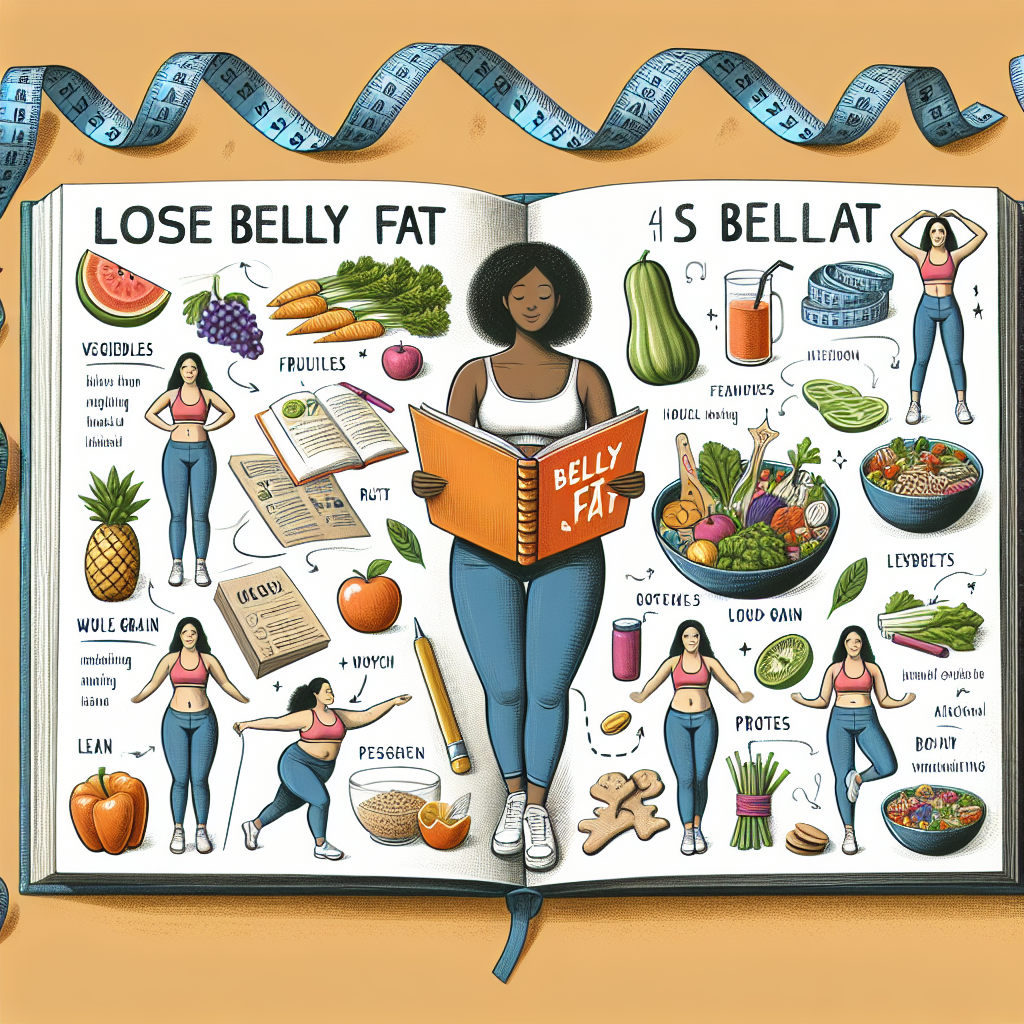You can’t spot-reduce fat from one area, but you can lose overall body fat and shrink your waistline by combining nutrition, movement, and recovery. Follow these steps to make steady, sustainable progress.
1) Set your starting point and goal
– Measure today: take waist circumference at the level of your navel, weigh yourself (ideally first thing in the morning after using the bathroom), and take front/side/back photos.
– Calculate your maintenance calories: use a reputable TDEE calculator or estimate body weight (lb) × 14–16 for a starting range. If you prefer kilograms, body weight (kg) × 30–35.
– Choose a realistic deficit: reduce maintenance calories by 300–500 per day to start. Expect 0.5–1% of body weight loss per week.
– Write a clear 8–12 week goal: example, lose 10–15 lb or reduce waist by 2–3 inches.
2) Build a calorie deficit you can stick to
– Use the plate method: half vegetables, a quarter lean protein, a quarter smart carbs (whole grains, potatoes, beans), plus 1–2 thumb-size portions of healthy fats.
– Eliminate stealth calories: replace sugar-sweetened drinks and fancy coffee with water or zero-calorie options; limit ultra-processed snacks.
– Eat mostly at set meals: 2–4 meals/day works well; minimize grazing.
– Portion guide per meal (typical adult): protein = 1–2 palm sizes; carbs = 1 cupped hand; fats = 1 thumb; veggies = 2 fists. Adjust based on progress and hunger.
– This week: plan 3–5 dinners in advance and shop for them; pre-portion snacks.
3) Prioritize protein at every meal
– Target 1.6–2.2 g protein per kg body weight per day (0.7–1.0 g per lb). Distribute across meals.
– Easy options: eggs, Greek yogurt, cottage cheese, tofu/tempeh, edamame, chicken/turkey breast, fish, lean beef, lentils/beans, protein shakes.
– Sample day: breakfast Greek yogurt parfait; lunch chicken, quinoa, and veggie bowl; snack protein shake and fruit; dinner salmon, potatoes, and broccoli.
– Prep: cook a batch of chicken, tofu, or lentils on Sunday; keep a ready-to-drink shake in your bag.
4) Load up on fiber and minimally processed carbs
– Aim for 25–38 g fiber daily through vegetables, fruits, legumes, oats, whole grains, nuts, and seeds.
– Swap refined carbs for whole versions: white rice to brown/wild rice, white bread to sprouted/whole grain, sugary cereal to oats.
– Pair carbs with protein and veggies to blunt blood sugar spikes and improve satiety.
– This week: add one piece of fruit and one big salad or veggie side every day.
5) Strength train 2–4 times per week
– Focus on full-body movements to preserve muscle and keep metabolism high.
– Sample 3-day plan (45–60 minutes):
Day A: squat 3×6–10, bench or push-ups 3×6–10, row 3×8–12, plank 3×30–45 sec
Day B: hinge (deadlift/hip hinge) 3×5–8, overhead press 3×6–10, lat pulldown/pull-ups 3×6–10, farmer carry 4×30–40 m
Day C: lunge pattern 3×8–12/side, incline press 3×8–12, cable or dumbbell row 3×8–12, side plank 3×20–30 sec/side
– Progression: when you hit the top of the rep range with good form, increase weight 2–5% next session.

– If new to lifting: start with 2 sets and lighter loads; prioritize form. Consider a coach or reputable beginner program.
6) Increase daily movement (NEAT)
– Set a step goal: 8,000–12,000 steps per day is a strong target for fat loss.
– Schedule movement snacks: 5–10 minutes of walking after meals; stand and stretch every hour.
– Stack habits: take calls walking, park farther away, use stairs.
– Track steps with a phone or wearable and nudge the average up 1,000 steps per week until you hit your target.
7) Add cardio you enjoy
– Aim for 150–300 minutes/week of moderate intensity (brisk walking, cycling, swimming) or 75–150 minutes of vigorous intensity, or a mix.
– Optional intervals 1–2 times/week: after warm-up, do 6–10 rounds of 30 seconds hard, 90 seconds easy.
– Keep intervals on non-lifting days or after shorter lifting sessions.
– Choose what you’ll actually do consistently; enjoyment beats perfection.
8) Sleep like it’s part of the plan
– Target 7–9 hours per night. Poor sleep increases hunger and cravings.
– Set a consistent sleep and wake time, including weekends when possible.
– Create a 30–60 minute wind-down: dim lights, read, stretch, or breathe; avoid screens if you can.
– Caffeine cutoff 8–10 hours before bed; alcohol disrupts sleep—limit or avoid near bedtime.
– Make your room cool, dark, and quiet.
9) Manage stress to curb belly-fat-friendly habits
– Practice a daily 5-minute stress tool: box breathing (inhale 4, hold 4, exhale 4, hold 4), a short walk, or journaling.
– Protect non-negotiables: movement, meals, and bedtime routines.
– Use boundaries: schedule focus blocks, limit doom-scrolling, and say no to overcommitment.
– If stress eating hits, pause-plan: drink water, wait 10 minutes, choose a protein-containing snack if still hungry.
10) Set alcohol and liquid-calorie rules
– Pick a weekly cap (for many, 0–4 drinks) and stick to it for 8–12 weeks.
– Choose lower-calorie options: spirits with soda water and citrus, light beer, or dry wine; alternate with water.
– Avoid sugary mixers and blended cocktails.
– Remember alcohol can blunt fat loss even if calories are matched; be strategic.
11) Hydrate and mind electrolytes
– Aim for roughly 30–35 ml/kg body weight per day (about half your body weight in ounces), more if you train hard or it’s hot.

– Start the day with a big glass of water; have a glass before each meal.
– If you sweat a lot, add a pinch of salt to water or use a low-sugar electrolyte mix.
12) Track, review, and adjust
– Weigh in 3–7 times per week and average the number; measure your waist weekly at the same time of day.
– If progress stalls for 2–3 weeks:
– Confirm adherence 80–90% of the time to food, steps, training, and sleep.
– Reduce daily calories by another 100–150 or add 1,500–2,500 steps per day.
– Consider a diet break: 7–14 days at estimated maintenance calories with continued protein and training.
– Celebrate non-scale wins: better energy, improved lifts, looser clothes.
13) Make your environment do the heavy lifting
– Stock your kitchen with ready-to-eat proteins, pre-cut veggies, fruit, whole grains, and sparkling water.
– Keep tempting, high-calorie snack foods out of sight or out of the house.
– Prep grab-and-go options on weekends: overnight oats, chili, grilled protein, chopped veggies.
14) Know when to get extra help
– If you have diabetes, thyroid issues, PCOS, are pregnant/postpartum, or take medications that affect weight or appetite, consult a healthcare professional for personalized guidance.
– A registered dietitian or certified trainer can tailor macros and training to your needs.
What to expect
– Weeks 1–2: learn portions, set routines, initial water-weight drop, better energy.
– Weeks 3–6: steady fat loss, strength gains, waistline changes.
– Weeks 7–12: noticeable body recomposition, habits feel easier.
– Long term: maintain with a slightly higher calorie intake, continued lifting, and solid sleep.
Quick start checklist for this week
– Plan and shop for 3 protein-centered dinners.
– Hit 10,000 steps daily.
– Train full-body twice.
– Sleep 7+ hours, 5 nights.
– Keep drinks to water, coffee/tea, or zero-calorie options.
Consistent, boring basics beat complicated hacks. Follow the steps, review weekly, and your waistline will follow.

